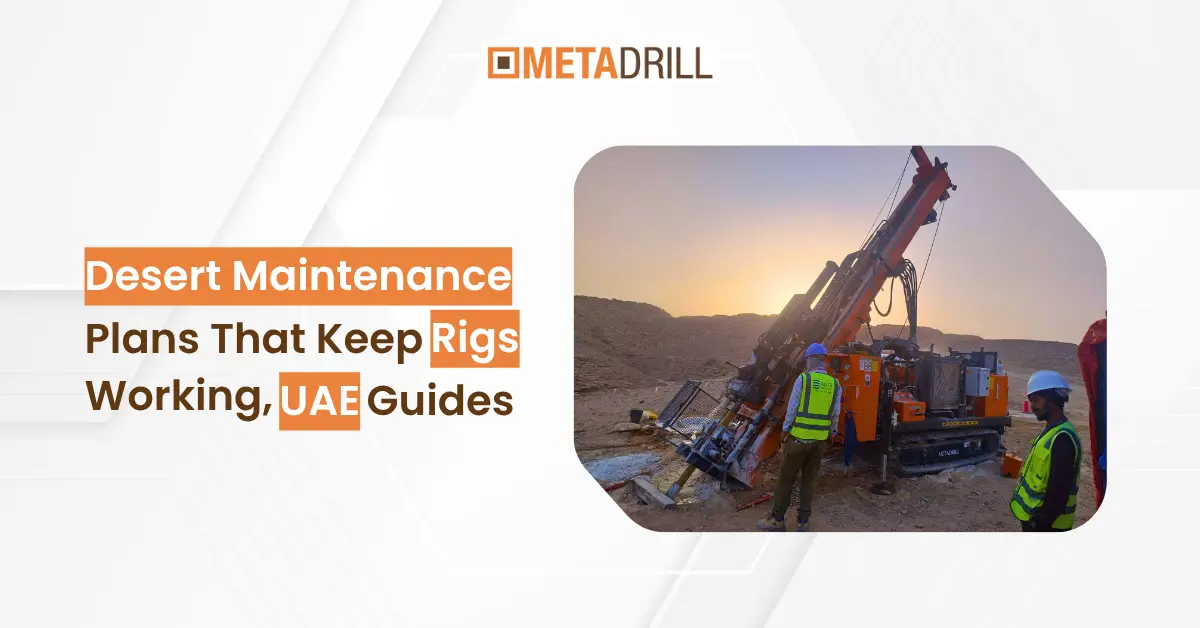
Desert sites punish geotechnical drilling rigs. Heat, dust, and long moves push components to failure unless you run a preventive plan tailored to UAE conditions.This guide turns field reality into a checklist, what to service, how often, and how to keep geotechnical drills delivering predictable meters, week after week.
Why maintenance matters: More than 75% of hydraulic and lube-system failures trace to contamination; dust-heavy environments amplify the risk.
Build for the Desert, Not the Brochure
The UAE reality: heat + dust + duty cycle
High ambient temperatures, frequent pad relocations, and suspended dust mean filters load quickly and fluids degrade faster. A geotechnical drilling company should design service intervals around real sand load and summer peaks, not generic hour counts.
Your goal
Keep oil clean, electronics cool, and moving parts sealed, so geotechnical drilling equipment holds spec under 45–50°C days and dust events, and geotechnical drills stay safe and productive.
Service Architecture That Works in Sand
Three-layer plan (daily, shift, campaign)
Daily (operator-led)
Air & breathers: Tap-clean pre-filters; inspect main elements; replace when ΔP flags.
Hydraulics quick check: Sight-glass level, foam, color; wipe ports before coupling.
Rod handling zone: Decrease grips, check guards; sand builds create pinch hazards.
Electrical & sensors: Blow out cabinets gently; confirm fans and door gaskets.
Cooling stack: Radiator–CAC–oil cooler: backflush with low-pressure air; log temps.
Shift (technician support)
ISO 4406 cleanliness check (spot tests) to trend oil condition; schedule kidney-loop filtration when codes drift.
Grease points: Use desert-grade lubricants; verify seals around the rotary head.
Return-line filters: Swap on ΔP alarm or hours, sand eats margin fast on MetaDrill drilling rigs.
Fasteners & mounts: Heat cycling loosens hardware; re-torque critical points.
Campaign (weekly/biweekly)
Full fluid analysis: viscosity, TAN/TBN, water ppm, particle count.
Calibration sweep: torque, RPM, pressure transducers, temp probes.
Hoses & looms: Replace sun-brittled sleeves; re-route where sandblasting occurs.
Cabin HVAC & overpressure: Keep the operator micro-environment clean to reduce fatigue across long MetaDrill geotechnical drilling shifts.
Keep the Core Systems Alive
Hydraulics: defend the lifeblood
Stage desert-grade filtration: pre-filter socks on breathers, high-efficiency return filters, and dedicated kidney-loop carts for fast cleanup.
Wipe every connection, one gritty coupling can seed a failure chain in geotechnical drilling equipment.
Log ΔP, temps, and ISO code after each kidney-loop; trend, don’t guess.
Cooling: heat is the quiet killer
Clean the cooling stack daily; align louvers to reduce sand ingestion.
Verify coolant mix and cap pressure; inspect shrouds and fan balance.
Use non-contact thermometers to map hot spots on geotechnical drills after long pulls.
Electronics: keep brains cool and sealed
Positive-pressure cabinet kits and clean filters keep dust out.
Mount critical controllers away from radiant surfaces; verify fan direction and airflow.
Label and seal spare ports; desert intrusion starts in forgotten holes.
Desert-Proofing the Wear Parts
Rotary head and string
Track bit hours and swap crowns early when fines spike; it protects rods and barrels.
Use thread compound sparingly; sand + paste = lapping grit.
Inspect jaws, dies, and slips; sand-polished jaws, slips, overheat, and deform rods, avoid cascading damage to drilling rig tools and equipment.
Fluids & returns
Mix fluids away from wind; screen and cover tanks.
Record density/viscosity every 20–30 minutes in fine sands; adjust before returns thin out.
Add loss-control materials at the first sign of seepage to keep circulation stable.
Scheduling That Survives Summer
Plan around the thermometer, not the calendar
Shift heavy pulls to early mornings or nights.
Increase inspection frequency when forecast highs exceed 45°C (common inland).
Pre-stage filters, belts, and cooler fins before heat waves so MetaDrill drilling rigs don’t wait on parts.
UAE inland stations touched 51.8°C on Aug 1, 2025, near the all-time national record, proof that thermal stress planning isn’t optional.
Team Habits That Protect Uptime
Make it cultural
Clean-as-you-go: rags on every panel; dust caps used every time.
One-minute filter talk: at toolbox meetings, hours, and what’s due.
Red-tag bad actors: hoses, connectors, or fans that repeatedly fail.
Photo logs: cooling stack, filter swaps, cabinet interiors, evidence beats memory.
Partner with your builder: MetaDrill geotechnical drilling support can tailor intervals to your geology and duty cycle; your geotechnical drilling company should own that learning loop.
You can also check: Operator Training that Lifts Daily Production and Safety
Conclusion: Maintenance Is Your Desert Advantage
Run desert-specific routines, and the environment becomes manageable. Protect hydraulics from grit, keep electronics cool and sealed, and schedule work around heat, not hope. When geotechnical drilling rigs and drills are serviced in the UAE, backed by disciplined operators and responsive partners like a proven geotechnical drilling company, you turn sand, sun, and distance into steady production. Align with the MetaDrill drilling rigs service philosophy, keep MetaDrill geotechnical drilling documentation close, and your geotechnical drilling equipment will stay on-spec when the mercury spikes.
Question to the public:
Keep geotechnical drilling rigs on-spec in UAE heat. Desert-ready maintenance, clean oil, cooler gear, sealed systems, smart schedules, for steadier meters!